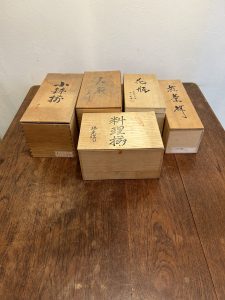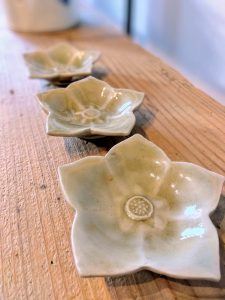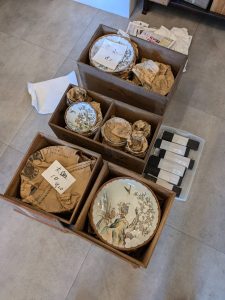ぽかぽか陽気の中、美しい黄葉に出くわしました(愛知県名古屋市千種区姫池通 骨董買取 古美術風光舎)
2024.12.03
朝の冷え冷えした空気から一転、日中は12月とは思えないほどのポカポカ陽気でございます。
今年は寒くなる時期が遅かったせいか12月にもかかわらず「黄葉」がまだ楽しめるのだそうです。
明治神宮外苑の見事に黄色く色づいた銀杏のトンネルの映像が流れており、今年は紅葉狩りに行けなかったなぁと寂しく思っておりましたら、幸運なことに本日見事な「黄葉」に出くわしました。風光舎からもそう遠くはない「千種公園」の銀杏並木です。
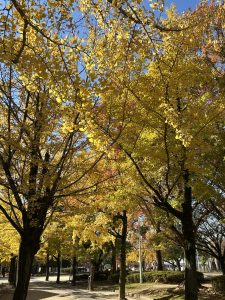
落ち葉をお掃除する方は大変でしょうが、落葉した赤い落ち葉が絨毯のようで美しいです。
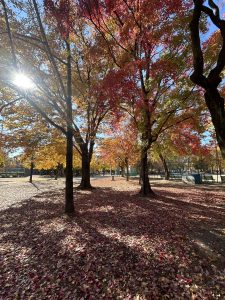
思いがけず身近で紅葉狩りを満喫できてラッキーでした。本日の千種公園のお散歩はおすすめです!
さて日中は暖かいのですが夜になると急激に冷える日が多く、先日ブログで飲酒を控えていると書いたばかりなのですが、寒さのせいか無性に体が日本酒や焼酎を求めます(笑)。ほんの少しなら体も温まってよいのではと、とうとう日本酒を購入してしまいました。とりあえずお猪口に一杯だけ、と思っておりましたがそれで済むはずもありませんでした…。今は美味しいお酒の肴を探すことが楽しみとなってしまい、あえなく断酒はあきらめました。
どうせ量を飲むなら、お猪口ではなくぐい呑みやコップでもいいのですが、ささやかな抵抗としてお猪口でちびちびと楽しんでおります。
そういえば風光舎にも愛知県瀬戸市ご出身の竹内真吾作の象嵌ぐい呑みがございました。土の素朴な味わいと独特なデザインが融合した不思議な魅力を持つ器で、お酒を注いでいいのかと一瞬戸惑いそうです。ぐい呑みは元々、茶事で向付として「なます」などの珍味をいれる器として使われており、食べ終わった器にお酒を入れて飲んだことから酒器として使われるようになったとのこと。竹内氏のぐい呑みもお料理を盛りつけても楽しめそうです。
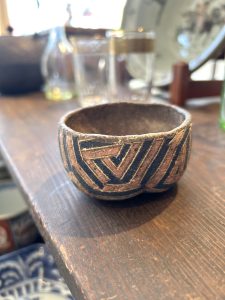
竹内真吾氏を調べて見ますと「炻器(せっき)」の作者とあります。炻器は焼き締めともいわれ、陶器と磁器の中間的なものとされています。
アルカリや鉄分が多めの粘土と多めの長石を使用し、長石が高温で焼かれることで液状化し素地にくい込むことで釉薬の役割を果たすのだとか。そのため吸水性が低くなり施釉はしないことが特徴とされています。陶器と磁器の焼成温度の間の1100~1300度の温度で焼かれます。
この「炻器」の「炻」という漢字ですが、なかなか変換できず不思議に思っておりましたら、どうやら中国から来た漢字ではなく、明治40年頃に作られた「国字」であるとのこと。1935年に出版された「陶器大辞典」によると、1907年ころに英語の ‵stone ware’ の訳語として作られたのだそうです。「石器」と音が同じになり区別するために火偏を付けて「炻器」とし、中国にも輸出されたとあります。
漢字を新たに作ってもいいのですね。そういえば子供が小学生の時に「創作漢字を作る」という宿題が出て頭を悩ませておりました。小学生の発想は豊かでユニークな漢字をひねり出しておりました。
実は「創作漢字コンテスト」というものが毎年行われており、今年は15回目を迎えたそうです。頭の体操になり面白かったのでご興味のある方は覗いてみてはいかがでしょうか。
それでは、また次の機会に。(スタッフH)
The cool morning air has changed, and during the daytime it is so warm and sunny that it is hard to believe that it is December.
This year, perhaps due to the late arrival of cold weather, we can still enjoy “yellow leaves” even though it is December.
I was sadly thinking that I could not go to the famous Meiji Jingu Gaien to see the yellow tunnels of the autumn leaves this year. It was a row of gingko trees in Chikusa Park, which is not far from the Fumikosha.
It must be hard for those who clean up the fallen leaves, but the red fallen leaves look like a carpet and are beautiful.
I was lucky to be able to enjoy autumn leaf viewing in an unexpectedly close neighborhood. A walk in Chikusa Park today is highly recommended!
It is warm during the day, but it suddenly gets cold at night. I just wrote in my blog the other day that I am trying to cut down on drinking, but perhaps it is because of the cold weather that my body is craving sake and shochu. I thought a little bit of sake would warm me up, so I finally bought some sake. I thought I would just have one cup of sake, but that was not enough…. Now I am looking forward to finding delicious snacks to go with my sake, and I have given up on sake.
If I am going to drink a large amount of sake, I could drink it in a cup or a sake cup instead of an inokuchi, but as a small measure of resistance, I am enjoying it in small doses with an inokuchi.
Speaking of which, Fukosha also has a Zogan (inlaid glass) sake cup made by Shingo Takeuchi, a native of Seto City, Aichi Prefecture. The simple taste of the clay and the unique design of the cups are so fascinating that you may wonder for a moment if you are allowed to pour alcohol into the cups. Originally, gugumini were used at tea ceremonies to hold delicacies such as “namasu” (sweetened young sardines) as mukozuke, and then used as drinking vessels after the meal was over, which is how they came to be used as sake vessels. Takeuchi’s guginomi can also be enjoyed when served with food.
Shingo Takeuchi is the creator of stoneware, which is also called “sekki. Stoneware is also called yakishime, and is considered to be a medium between ceramic and porcelain.
It is made of clay with high alkali and iron content and feldspar, which is liquefied by being fired at high temperatures and penetrates into the base material, thus serving as a glaze. The result is that the water absorbency is low and no glaze is applied. Stoneware is fired at temperatures between 1100 and 1300 degrees Celsius, between the firing temperatures of ceramics and porcelain.
According to the “Dictionary of Ceramics” published in 1935, the Chinese character for “stoneware” was created around 1907 as a translation of the English word “stoneware. The word was coined around 1907 as a translation of the English word ‵stone ware‵. The word “stoneware” was exported to China as well.
So you can create a new kanji character. I remember when my child was in elementary school, he had a homework assignment to “create a creative Kanji character” and it was a headache for him. The elementary school students were full of ideas and came up with unique kanji.
In fact, the “Kanji Creation Contest” is held every year, and this year marked the 15th year. It was an interesting exercise for the brain, so if you are interested, why not take a look?
See you next time. (Staff H)
*******************
ご実家の整理やお片付けなどをされている方のご相談などが多くございます。
お片付けなどくれぐれもご無理のないようになさってくださいませ。
風光舎では古美術品や骨董品の他にも絵画や宝石、趣味のお品など様々なジャンルのものを買受しております。
お片付けをされていて、こういうものでもいいのかしらと迷われているものでも、どうぞお気軽にご相談下さいませ。
また風光舎は、出張買取も強化しております。ご近所はもちろん、愛知県内、岐阜県、三重県その他の県へも出張いたします。
まずは、お電話お待ちしております。
愛知県名古屋市千種区姫池通
骨董 買取【古美術 風光舎 名古屋店】
TEL052(734)8444
10:00-18:00 OPEN
#出張買取#骨董#古美術#骨董品#絵画#版画#茶道具#刀剣#彫刻

